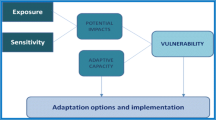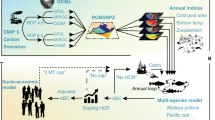Abstract
Climate change driven alterations in the distribution and abundance of marine species, and the timing of their life history events (phenology), are being reported around the globe. However, we have limited capacity to detect and predict these responses, even for comparatively well studied commercial fishery species. Fisheries provide significant socio-economic benefits for many coastal communities, and early warning of potential changes to fish stocks will provide managers and other stakeholders with the best opportunity to adapt to these impacts. Rapid assessment methods that can estimate the sensitivity of species to climate change in a wide range of contexts are needed. This study establishes an objective, flexible and cost effective framework for prioritising future ecological research and subsequent investment in adaptation responses in the face of resource constraints. We build on an ecological risk assessment framework to assess relative sensitivities of commercial species to climate change drivers, specifically in relation to their distribution, abundance and phenology, and demonstrate our approach using key species within the fast warming region of south-eastern Australia. Our approach has enabled fisheries managers to understand likely changes to fisheries under a range of climate change scenarios, highlighted critical research gaps and priorities, and assisted marine industries to identify adaptation strategies that maximise positive outcomes.


Similar content being viewed by others
References
Bates AE, Pecl GT, Frusher S, Hobday AJ, Wernberg T, Smale DA, Dulvy N, Edgar GJ, Feng M, Fulton EA, Hill N, Holbrook NJ, Radford B, Slawinski D, Sunday JM, Thompson PA, Watson R (2014). Evaluating pathways of geographic range extensions and contractions. Global Environ Chang 26:27–38
Bernhardt J, Leslie H (2013) Resilience to climate change in coastal marine ecosystems. Marine Science 5:371–392. doi:10.1146/annurev-marine-121211-172411
Cinner J, Huchery C, Darling E, Humphries A, Graham N, Hicks C, Marshall N, McClanahan T (2013) Evaluating social and ecological vulnerability of coral reef fisheries to climate change. PLoS One 8:e74321. doi:10.1371/journal.pone.0074321
Cortés E, Arocha F, Beerkircher L, Carvalho F, Domingo A, Heupel M, Holtzhausen H, Santos MN, Ribera M, Simpfendorfer C (2010) Ecological risk assessment of pelagic sharks caught in Atlantic pelagic longline fisheries. Aquat Living Resour 23:25–34. doi:10.1051/alr/2009044
Edwards M, Richardson AJ (2004) Impact of climate change on marine pelagic phenology and trophic mismatch. Nature 430:881–884. doi:10.1038/nature02808
Frusher SD, Hobday AJ, Jennings SM, Creighton C, D’Silva D, Haward M, Holbrook NJ, Nursey-Bray M, Pecl GT, van Putten EI (2014) A short history of a marine hotspot - from anecdote to adaptation in south-east Australia. Rev Fish Biol Fish
Fulton EA (2011) Interesting times: winners, losers, and system shifts under climate change around Australia. ICES J Mar Sci 68:1329–1342. doi:10.1093/icesjms/fsr032
García V, Lucifora L, Myers R (2008) The importance of habitat and life history to extinction risk in sharks, skates, rays and chimaeras. P Roy Soc B-Biol Sci 275:83–89. doi:10.1098/rspb.2007.1295
Griffith GP, Fulton EA, Richardson AJ (2011) Effects of fishing and acidification-related benthic mortality on the southeast Australian marine ecosystem. Glob Chang Biol 17:3058–3074
Griffith GP, Fulton EA, Gorton R, Richardson AJ (2012) Predicting Interactions among fishing, ocean warming, and ocean acidification in a marine system with whole-ecosystem models. Conserv Biol. doi:10.1111/j.1523-1739.2012.01937.x
Hill KL, Rintoul SR, Coleman R, Ridgway KR (2008) Wind forced low frequency variability of the East Australia Current. Geophys Res Lett 35(8). doi: 10.1029/2007GL032912
Hobbs RJ, Kristjanson LJ (2003) Triage: how do we prioritize health care for landscapes? Ecol Manag Restor 4(1):S39–S45. doi:10.1046/j.1442-8903.4.s.5.x
Hobday AJ, Lough J (2011) Projected climate change in Australian aquatic environments. Mar Freshw Res 62:1000–1014. doi:10.1071/MF10302
Hobday A, Pecl G (2014) Identification of global marine hotspots: sentinels for change and vanguards for adaptation action. Rev Fish Biol Fish. doi:10.1007/s11160-013-9326-6
Hobday AJ, Griffiths S, Ward T (2009) Pelagic fishes and sharks. In a marine climate change impacts and adaptation report card for Australia 2009 (Eds. ES Poloczanska, AJ Hobday and AJ Richardson) NCCARF Publication 05/09, ISBN 978-1-921609-03-9. http://www.oceanclimatechange.org.au
Hobday AJ, Smith ADM, Stobutzki I, Bulman C, Daley R, Dambacher J, Deng R, Dowdney J, Fuller M, Furlani D, Griffiths SP, Johnson D, Kenyon R, Knuckey IA, Ling SD, Pitcher R, Sainsbury KJ, Sporcic M, Smith T, Walker T, Wayte S, Webb H, Williams A, Wise BS, Zhou S (2011) Ecological risk assessment for the effects of fishing. Fish Res 108:372–384. doi:10.1016/j.fishres.2011.01.013
Hodgkinson JA, Hobday AJ, Pinkard EA (2014) Climate adaptation in Australia’s resource-extraction industries: ready or not? Reg Environ Chang. doi:10.1007/s10113-014-0618-8
Hoegh-Guldberg O, Bruno JF (2010) The impact of climate change on the world’s marine ecosystems. Science 328:1523–1528. doi:10.1126/science.1189930
Kolar CS, Lodge DM (2001) Progress in invasion biology: predicting invaders. Trends Ecol Evol 16(4):199–204. doi:10.1016/S0169-5347
Last PR, White WT, Gledhill DC, Hobday AJ, Brown R, Edgar GJ, Pecl G (2011) Long-term shifts in abundance and distribution of a temperate fish fauna: a response to climate change and fishing practices. Glob Ecol Biogeogr 20(1):58–72. doi:10.1111/j.1466-8238.2010.00575.x
Ling SD, Johnson CR, Ridgway K, Hobday AJ, Haddon M (2009) Climate-driven range extension of a sea urchin: inferring future trends by analysis of recent population dynamics. Glob Chang Biol 15:719–731. doi:10.1111/j.1365-2486.2008.01734.x
MacNeil MA, Graham NAJ, Cinner JE, Dulvy NK, Loring PA, Jennings S, Polunin VC, Fisk AT, McClanahan TR (2010) Transitional states in marine fisheries: adapting to cope with predicted global change. Phil Trans R Soc B 365(1558):3753–3763. doi:10.1098/rstb.2010.0289
Madin EMP, Ban NC, Doubleday ZA, Holmes TH, Pecl GT, Smith F (2012) Socio-economic and management implications of range-shifting species in marine systems. Glob Environ Chang 22:137–146. doi:10.1016/j.gloenvcha.2011.10.008
Marshall N, Tobin R, Marshall P, Gooch M, Hobday A (2013) Social vulnerability of marine resource users to extreme weather events. Ecosystems 16:797–809. doi:10.1007/s10021-013-9651-6
Musick JA, Harbin MM, Berkeley SA, Burgess GH, Eklund A, Findley L, Gilmore RG, Golden JT, Ha DS, Huntsman GR, McGovern JC, Parker SJ, Poss SG, Sala E, Scmidt TW, Sedberry GR, Weeks H, Wright SG (2000) Marine, estuarine and diadromous fish stocks at risk of extinction in North America (exclusive of Pacific salmonids). Fisheries 25(11):6–30
Nursey-Bray M, Pecl GT, Frusher S, Gardner C, Haward M, Hobday AJ, Jennings S, Punt A, Revill H, van Putten I (2012) Communicating climate change: climate change risk perceptions and rock lobster fishers, Tasmania. Mar Policy 36:753–759. doi:10.1016/j.marpol.2011.10.015
Pecl G, Frusher S, Gardner C, Haward M, Hobday A, Jennings S, Nursey-Bray M, Punt A, Revill H, van Putten I (2009) The east coast Tasmanian rock lobster fishery–vulnerability to climate change impacts and adaptation response options. Dept of Climate Change, Australia
Pecl GT, Ward T, Doubleday Z, Clarke S, Day J, Dixon C, Frusher S, Gibbs P, Hobday A, Hutchinson N, Jennings S, Jones K, Li X, Spooner D, Stoklosa R (2011). Risk assessment of impacts of climate change for key marine species in South Eastern Australia. Species profiles: fisheries and aquaculture risk assessment. Fisheries research and development corporation, Project 2009/070. http://www.imas.utas.edu.au/__data/assets/pdf_file/0017/222092/Risk-assessment-report_Part2-Species-profiles-02.pdf
Pitt NR, Poloczanska ES, Hobday AJ (2010) Climate-driven range changes in Tasmanian intertidal fauna. Mar Freshw Res 61:963–970
Poloczanska ES, Brown CJ, Sydeman WJ, Kiessling W, Schoeman DS, Moore PJ, Brander K, Bruno JF, Buckley LB, Burrows MT, Duarte CM, Halpern BS, Holding J, Kappel CV, O’Connor MI, Pandolfi JM, Parmesan C, Schwing F, Thompson SA, Richardson AJ (2013) Global imprint of climate change on marine life. Nat Clim Chang 3:919–925. doi:10.1038/nclimate1958
Ridgway KR (2007) Long-term trend and decadal variability of the southward penetration of the East Australian Current. Geophys Res Lett 34:L13613. doi:10.1029/2007GL030393
Rijnsdorp A, Peck M, Engelhard G, Mollmann C, Pinnegar J (2009) Resolving the effect of climate change on fish populations. ICES J Mar SCI 66:1570–1583. doi:10.1093/icesjms/fsp056
Roy K, Jablonski D, Valentine JW (2001) Climate change, species range limits and body size in marine bivalves. Ecol Lett 4(4):366–370
Scandol J, Ives AR, Lockett MM (2009) Development of national guidelines to improve the application of risk-based methods in the scope, implementation and interpretation of stock assessments for data-poor species. FRDC Project No. 2007/016. Industry & Investment NSW, Sydney
Smith ADM, Smith DC, Tuck GN, Klaer N, Punt AE, Knuckey IA, Prince JD, Morison A, Kloser R, Haddon M, Wayte S, Day J, Fay G, Pribac F, Fuller M, Taylor B, Little R (2008) Experience in implementing harvest strategies in Australia’s south-eastern fisheries. Fish Res 94:373–379. doi:10.1016/j.fishres.2008.06.006
Sterk M, Gort G, Klimkowska A, Ruijven J, Teeffelen A, Wamelink G (2013) Assess ecosystem resilience: linking response and effect traits to environmental variability. Ecol Indic 30:2127. doi:10.1016/j.ecolind.2013.02.001
Thackeray SJ, Sparks TH, Frederiksen M, Burthe S, Bacon PJ, Bell JR, Botham MS, Tm B, Bright PW, Carvalho L, Cluuton-Brock T, Dawson A, Edwards M, Elliott JM, Harrington R, Johns D, Jones ID, Leech DI, Roy DB, Scott WA, Smith M, Smithers RJ, Winfield IJ, Wanless S (2010) Trophic level asynchrony in rates of phenological change for marine, freshwater and terrestrial environments. Glob Chang Biol 16(12):3304–3313. doi:10.1111/j.1365-2486.2010.02165.x
van Putten IE, Jennings S, Frusher S, Gardner C, Haward M, Hobday AJ, Nursey-Bray M, Pecl G, Punt A, Revill H (2013) Building blocks of economic resilience to climate change: a fisheries example. Reg Environ Chang 13:1313–1323. doi:10.1007/s10113-013-0456-0
Walther GR, Post E, Convey P, Menzel A, Parmesan C, Beebee TJC, Fromentin J-M, Hoegh-Guldberg O, Bairlein F (2002) Ecological responses to recent climate change. Nature 416:389–395. doi:10.1038/416389a
Acknowledgments
We thank Elsa Gärtner, Luisa Forbes, Fiona Brodribb, Jemina Stuart-Smith and Ben Chuwen for assisting with this work. State agency and Commonwealth resource managers provided jurisdictional priority species rankings. This study was undertaken under the guidance of the El-nemo SEAP Program Management Committee with Ingrid Holliday and Dallas D’Silva coordinating the program. The authors thank the individuals who contributed to, edited or reviewed the species assessments and/or provided expertise for the sensitivity assessment process. This was FRDC project 2009–070 with funding provided through the El Nemo—South Eastern Australia Program, supported by the VDPI, PIRSA, Industry & Investment NSW, Tasmanian DPIPWE, AFMA, FRDC, CSIRO, SARDI, IMAS, Commonwealth DAFF and was also supported through funding from the Australian Government’s Climate Change Research Program.
Author information
Authors and Affiliations
Corresponding author
Electronic supplementary material
Below is the link to the electronic supplementary material.
ESM 1
(DOCX 78 kb)
Rights and permissions
About this article
Cite this article
Pecl, G.T., Ward, T.M., Doubleday, Z.A. et al. Rapid assessment of fisheries species sensitivity to climate change. Climatic Change 127, 505–520 (2014). https://doi.org/10.1007/s10584-014-1284-z
Received:
Accepted:
Published:
Issue Date:
DOI: https://doi.org/10.1007/s10584-014-1284-z




